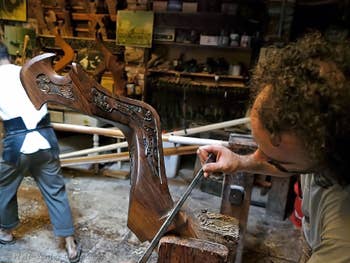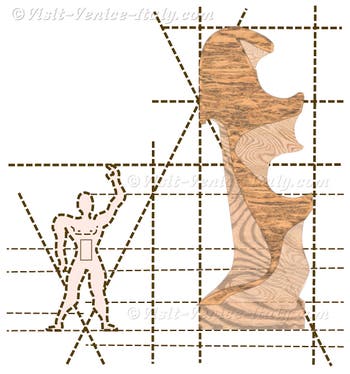Remeri Sculptors of Forcole

Paolo Brandolisio Remer, in his workshop Forcola (pitchfork) is the fulcrum of the oar of a boat: it is the chief part which is subjected to all restrictions of maneuvering and propulsion.
Gondole (gondola in the singular) and their forcole (in the plural) are such a particular form that they are exclusively made in Venice.
Squeri construct gondole and Remeri fabricate oars and sculpt Forcole.
Each its own specialty, which is not the case for the squeri of the Lagoon who construct different leasure or working boats and then deliver them already equipped with oars and forcole.
Remeri are artisans who work for the gondoliers and the regatta enthusiast.
Gondola Ride in Venice
Smartphone Tickets Accepted
St Mark Canals + Grand Canal €36 ➤
Venice Classic Gondola €41 ➤
Gondola Bridge of Sighs €41 ➤
Gondola Ride + Audioguide €42 ➤
Venice Grand Canal €30-39 ➤
St Mark Basilica + Gondola €84 ➤
Doges+St Mark+Gondola €65-120 ➤
Doges + St Mark + Gondola €140 ➤
Doges-S.Mark-Gondola-Islands €149+ ➤
Private Gondola G.Canal €147-189 ➤
The Forcole of Gondole, the work of a master
There are three kinds of forcola: forcola of prow, poop and side.
The Forcola size corresponds to height and the weight of the gondolier The forcola of a gondola is a very particular piece in the way that it must be sharpened according to height and weight of the gondolier and by taking into account, as much as possible, how he rows and his bearing on the boat.
Given that the gondolier rows standing on a platform at the gondola's back, while the oarsman of a sandolo simply stands on the bottom of his boat, the full edge of the gondola is therefore lower, so the forcola of a gondola must be higher than that of a sandolo.
The tallest forcole are indeed the forcole of gondole.
Paolo Brandolisio is a remer who was trained by the maestro Giuseppe Carli, and has taken over his workshop for several years.
He explained us that the best wood to make a forcola is the walnut, but he can use also the pear tree or the cherry tree.
For a forcola of gondola it takes a quarter of trunk of hundred-year-old walnut coming from northern Italy or from Yugoslavia; the piece is first rough-hewed in the saw following lines pointed out by the gauge.
Then the work of sculpture is made with adze and drawknife.
Contrary to what you may think, the amazing form of the forcola is not from imagination or by chance: the forcole are subjected to very great stress by the morsi (bits) which are round notches on which the handle of the oar rests.
The site of every bit corresponds to the precise position of the support of the necessary oar to maneuver the gondola: going forward or reverse, short turn or rotation in place, there are eight bits in all.
Which make the unique and splendid shape of the forcola!
Mark Twain, in his book Innocents Abroad (1869), was admiring the Gondolier's skills:
“The stern of the boat is decked over and the gondolier stands there.
He uses a single oar — a long blade, of course, for he stands nearly erect.
A wooden peg, a foot and a half high, with two slight crooks or curves in one side of it and one in the other, projects above the starboard gunwale.
Against that peg the gondolier takes a purchase with his oar, changing it at intervals to the other side of the peg or dropping it into another of the crooks, as the steering of the craft may demand — and how in the world he can back and fill, shoot straight ahead, or flirt suddenly around a corner, and make the oar stay in those insignificant notches, is a problem to me and a never diminishing matter of interest.
I am afraid I study the gondolier's marvelous skill more than I do the sculptured palaces we glide among.
He cuts a corner so closely, now and then, or misses another gondola by such an imperceptible hair-breadth that I feel myself “scrooching”, as the children say, just as one does when a buggy wheel grazes his elbow.
But he makes all his calculations with the nicest precision, and goes darting in and out among a Broadway confusion of busy craft with the easy confidence of the educated hackman.
He never makes a mistake.”
Mark Twain — Innocents Abroad
About thirty hours are needed to complete a forcola which the gondolier will be able to normally use a good twenty years, by coating the bits of lard regularly to protect them from friction.
The single oar of the gondola measures about 4.2 meters long and it is made from exotic wood of Indonesia.
They are manufactured and repaired in the workshop of Mister Paolo Brandolisio.
The forcola is coated with oil before being delivered for a €950 price, or more, if it is decorated.
The price of this “beautiful gear box” custom-made to drive a gondola is of a “mere” €25,000; however it only runs on elbow grease!
If you want to bring back at home a hand sculpted forcole, Paolo Brandolisio carves scaled down models. A very nice model of about one-third of real size costs €150.
The workshop of Paolo Brandolisio
4725, Calle Corte Rota30122 Venezia
Phone and Fax : +39 041 522 41 55
Back to Top of Page

